Minneapolis Man Allegedly Sets House on Fire, One Killed
I still remember reading about that night in northeast Minneapolis, and it hit me how quickly life can change. On September 24, just before 11:20 p.m., firefighters were called to a house on the 900 block of 22nd Avenue Northeast. By the time they arrived, flames had already taken hold, and tragically, one man was found dead inside. Three others had to leave their homes, displaced and shaken.
What really makes this case stick with me is the witness accounts. Neighbors told police that they saw Andrew John Nietz at the victim’s unit hours before the fire started—around 8:30 p.m. Some remembered that Nietz had previously threatened to set the house on fire. Others spoke about the tension between him and the victim, noting that arguments often escalated when they drank together.
Even small details matter here. The victim’s car, parked outside the building earlier, disappeared during the fire and was later found in Minneapolis, connected to Nietz during a traffic stop. Phone location data also put him at the victim’s home from just after 8 p.m. until the fire broke out. Piece by piece, the picture that investigators painted is chilling—but it also shows how crucial every witness observation was in understanding what happened.
Thinking about it, it’s a reminder of how quickly situations can escalate. I can’t help but wonder—if neighbors or authorities had noticed the early warning signs, could this have been prevented?
Have you ever witnessed something concerning in your neighborhood and wondered whether to speak up? I’d love to hear your thoughts—share your experience below.
Victim Profile

When I read about the victim, Housten R. Housley, 39, it really put a human face on this tragedy. According to KSTP, he lived in the multi-unit building on 22nd Avenue Northeast. Friends and neighbors described him as someone who genuinely cared about others—a person who would help without being asked.
His mother, who also owned the building, shared that Housten and the suspect had known each other since childhood. They weren’t strangers, but they had a complicated history. She had previously rented a room to Andrew John Nietz but had to evict him because of drug issues. Even so, the tension didn’t erase the years of shared history, making the tragedy even harder to process.
For me, this section is a reminder that behind every headline is a real person, with family and community ties. And for you, it’s an opportunity to reflect on the people around you and the stories that go unseen until something terrible happens.
Unfortunately, incidents like this aren’t isolated; just last year, a house fire in Fairfax left one dead and two others injured, showing how quickly emergencies can escalate.
Takeaway: Knowing the victim’s background gives context—it helps us understand the scale of loss and why safety in our communities is so important.
Suspect Details and Charges
Andrew John Nietz, 41, now faces serious criminal charges. According to FOX9, he is charged with second-degree murder and first-degree arson. The details in the court documents paint a disturbing picture: witnesses saw him at the victim’s unit hours before the fire, and there were previous threats to burn the house down.
Nietz also has a history of arson. In 2012, he started a fire at the Mall of America, and in 2023, he set a trash can on fire at the MSP Airport. These past incidents make it harder to dismiss the severity of the current charges.
His first court appearance is scheduled for Monday, and he’s currently held at Hennepin County Jail on a probation violation. Reading this, I felt the weight of accountability in the legal system—but also how past patterns of behavior often serve as warning signs.
Takeaway: This isn’t just about the crime—it’s about understanding patterns, being aware, and recognizing that repeated risky behavior has consequences for everyone around.
Evidence and Investigation Insights
One of the most striking parts of this case is how methodically the investigators pieced everything together. Witnesses reported seeing Nietz at the victim’s home, which was corroborated by phone location data from 8:06 p.m. until the fire. The victim’s car, missing during the fire, was later linked to Nietz in a traffic stop.
As I read through the investigation details, it became clear how important every small observation was. A neighbor noticing smoke, a car parked outside, even recollections of past arguments—all of these elements built a strong case.
For you, it’s a reminder that attention to detail matters. If you see something suspicious or unusual, reporting it can prevent disasters or help authorities act faster.
Investigators often face similar challenges elsewhere; for instance, authorities are still piecing together details from a recent fire in Westmoreland County that damaged a home while officials continue their investigation.
Takeaway: Evidence is often collected from ordinary people paying attention. Your awareness can make a difference.
Community and Family Impact
The fire didn’t just destroy a home—it shook the whole neighborhood. Three residents were displaced, and the community expressed shock and grief over the loss. For Housten’s family, the pain is unimaginable. His mother, who also owns the building, not only lost her son but faced the stress of a damaged property and displaced tenants.
It’s easy to focus only on the crime, but the ripple effects are massive. Neighbors are left questioning safety, residents worry about repeat incidents, and the family faces emotional and financial strain.
If you live in a close-knit community, this story makes me think about the value of looking out for one another. Small gestures—checking in on neighbors, reporting suspicious behavior, installing smoke detectors—can help prevent such tragedies.
Takeaway: The human cost of incidents like this goes beyond headlines. Awareness and community support are crucial.
I often come across additional updates and local safety discussions shared by residents in real time. You can join conversations like these on WhatsApp to stay informed and exchange tips.
Arson Awareness and Safety Measures

This case is a hard lesson on how quickly a situation can escalate. Arson isn’t just a “property crime”—it’s life-threatening. I want you to think about your own space: do you have working smoke detectors? Are you aware of potential risks in your neighborhood?
Here are practical steps that could help:
- Ensure smoke alarms are installed and tested regularly.
- Pay attention to unusual behavior around your building or street.
- Encourage open communication with neighbors. If someone seems distressed or dangerous, alert authorities before it’s too late.
- Familiarize yourself with emergency procedures, like evacuation routes and fire extinguishers.
For me, the takeaway is clear: prevention starts with awareness. You don’t need to wait for a tragedy to understand the importance of safety.
Look around your home and community tonight—what’s one safety step you could take immediately? Share it with me or your neighbors and start a conversation about prevention.
Historical Context of Suspect’s Arson Cases
Reading about Andrew John Nietz’s past makes you pause. He isn’t new to fire-related offenses. In 2012, he started a fire at the Mall of America, and in 2023, he set a trash can on fire at MSP Airport. These aren’t minor incidents—they highlight a pattern of risky and dangerous behavior.
What’s important here is understanding patterns. For investigators, these prior convictions provide context for his actions and help establish risk. For you, it’s a reminder that repeated dangerous behavior shouldn’t be ignored. Warning signs often exist before tragedy strikes.
Sadly, fires with deadly outcomes have occurred across the country, like in Cumberland County, where a home was destroyed and a man was found dead nearby, highlighting the widespread risks of residential fires.
Takeaway: Historical patterns matter. Paying attention to repeated risky actions—whether in public spaces or within your own community—can be lifesaving.
Key Lessons and Awareness
I want to step back for a moment and think about what we can learn from this incident. It’s easy to read news about a house fire and move on, but the lessons are real:
- Community vigilance saves lives – Neighbors noticing something unusual or reporting early signs can prevent escalation.
- Know the risks of arson – It’s not just property damage; it’s a threat to human life.
- Patterns of behavior matter – Repeated threats or previous incidents can foreshadow serious consequences.
I also think about how small preventive actions could make a difference: checking smoke alarms, maintaining communication with neighbors, and staying alert to suspicious activity.
Takeaway: Awareness is your first line of defense. Understanding risks, people’s patterns, and small steps you can take can help protect your family and community.
For more real-life stories and safety tips, check out our Home Incidents section.
Disclaimer: The information in this article is based on reports available at the time of writing. Details may change as the investigation and legal proceedings continue. This content is for informational purposes only and is not legal advice.


